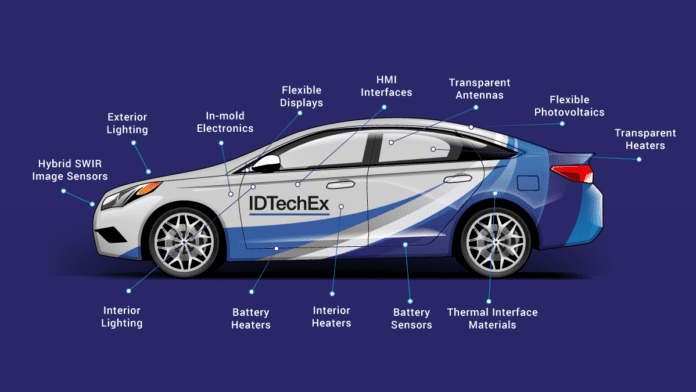IDTechEx has released a new technical market research report, “Printed and Flexible Electronics for Automotive Applications 2021-2031: Technologies and Markets”, on the current status of printed/flexible electronics in all aspects of automotive design and manufacturing, along with future opportunities created by these transitions.
It is an exciting time for the automotive industry, with technological transitions towards electric vehicles and increased autonomy occurring simultaneously. This of course creates extensive opportunities for many new technologies, including printed/flexible electronics. For example, the ability to make electronics on thin flexible substrates enables weight to be reduced, a key consideration for electric vehicles. Furthermore, the conformality associated with flexible electronics is highly suited to emerging automotive interior design trends with organic curves replacing flat surfaces.
This new IDTechEx report, “Printed and Flexible Electronics for Automotive Applications 2021-2031: Technologies and Markets”, is structured around three key technological transitions: electrification, autonomy, and an increased focus on the interior for differentiation.
Applications for printed/flexible electronics in vehicle powertrains, interiors and even exteriors. Source: IDTechEx
Electric vehicles. The accelerating transition to electric vehicles is well documented, with multiple countries announcing that sales of petrol/diesel fuelled new cars will become illegal at various points in the 2030s. It is clearly desirable for EV batteries to always work as efficiently as possible to increase vehicle range for a given weight. However, battery capacity is strongly dependent on temperature. This creates an opportunity for printed arrays of temperature sensors to provide local monitoring and for printed heaters to be integrated within the same functional film.
Increased levels of autonomy. Vehicles across the price range now contain sophisticated ‘advanced driver assistance systems (ADAS)’. Over time the level of autonomy will increase, with full Level 5 autonomy expected in some vehicles within a decade. This creates opportunities for multiple sensor technologies and associated features such as transparent heaters, integrated antennas, and even low-resolution flexible displays for the exterior to interact with pedestrians.
Differentiation shifts from powertrain to interior/cockpit. Car manufacturers are increasingly turning to interior design and features to differentiate their products. Given their lightweight and conformable nature, this transition means that interior applications arguably provide the greatest automotive opportunity for printed/flexible electronics. This trend is already being seen with the rapidly increasing adoption of displays, which is set to continue and extend to curved and flexible displays.
Human machine interface (HMI) technologies, more simply described as pressure or touch sensors, are especially promising. Already widely used in seat occupancy sensors, printed pressure sensors are likely to find their way into control panels to provide a wider range of inputs than purely capacitive touch sensors without the expense of mechanical switches.
Many of these touch sensors are likely to be produced via in-mold electronics. By combining the electronics with the thermoformed plastic, it enables integrated systems such as center consoles and overhead control panels to be much lighter, simpler, and easier to manufacture. Indeed, IDTechEx forecast IME to be an approximately $1.3 bn market by 2031.
Other opportunities for printed/flexible electronics within vehicle interiors include printed heaters, which enable heaters to be incorporated within touchpoints. This is significantly more efficient than space heating through the ventilation system, and much more responsive – flexible printed heaters can even be transparent!
Overview
In summary, extensive opportunities for printed and flexible electronics are being created by the transition to electric and autonomous vehicles – these technologies include sensors within EV batteries, interior HMI components, and displays, new manufacturing methodologies such as in-mold electronics (IME), and even exterior heating and lighting. The new report “Printed and Flexible Electronics for Automotive Applications 2021-2031: Technologies and Markets” outlines the current status and opportunities for printed/flexible electronics across 11 application areas, along with 10-year printed electronics automotive market forecasts by revenue and volume, multiple application case studies and assessments of commercial and technological readiness. The report also includes multiple company profiles based on interviews with early-stage and established companies. Further details and downloadable sample pages can be found at www.IDTechEx.com/PEAuto, and for the full portfolio of Printed and Flexible Electronics research available from IDTechEx please visit www.IDTechEx.com/Research/PE.
About IDTechEx
IDTechEx guides your strategic business decisions through its Research, Subscription and Consultancy products, helping you profit from emerging technologies. For more information, contact research@IDTechEx.com or visit www.IDTechEx.com.
Help keep news FREE for our readers
Supporting your local community newspaper/online news outlet is crucial now more than ever. If you believe in independent journalism, then consider making a valuable contribution by making a one-time or monthly donation. We operate in rural areas where providing unbiased news can be challenging. Read More About Supporting The West Wales Chronicle





















